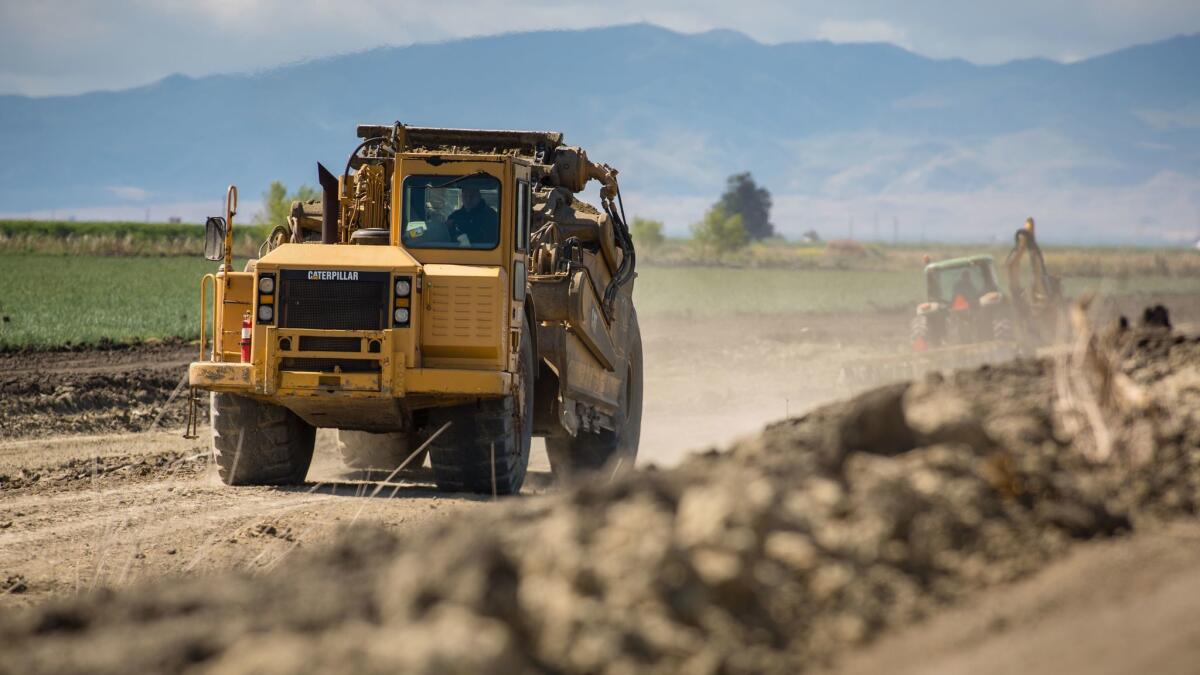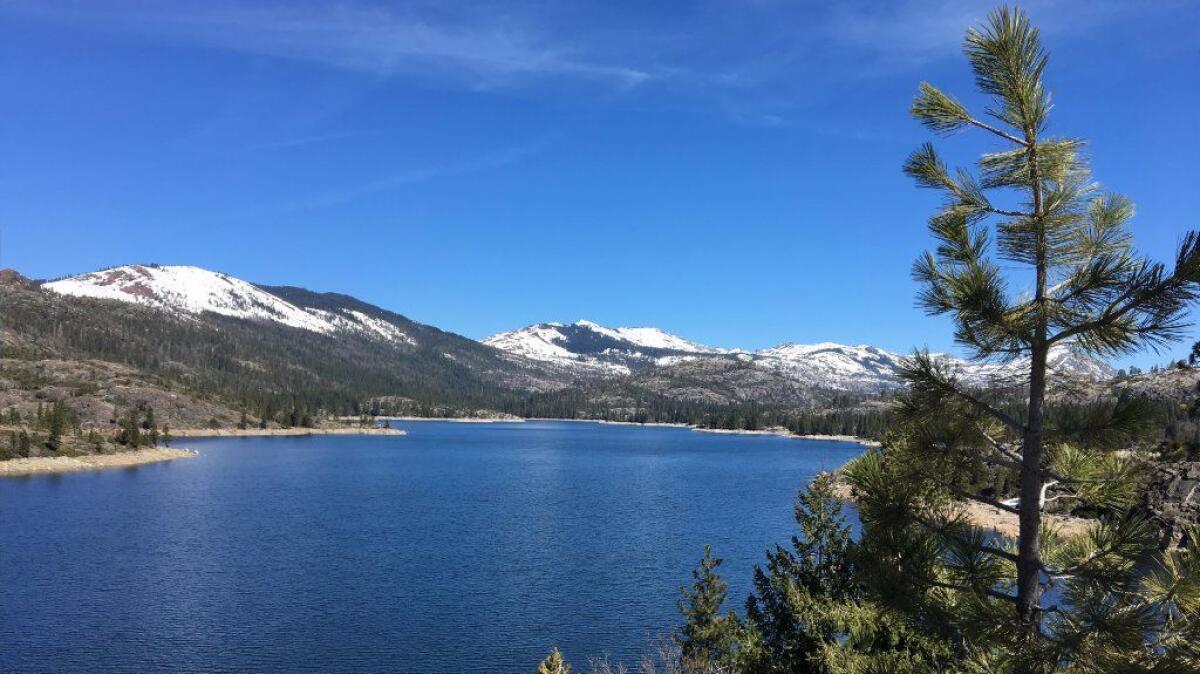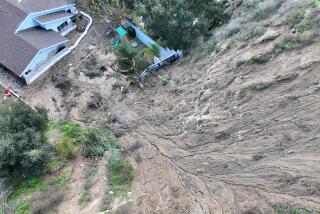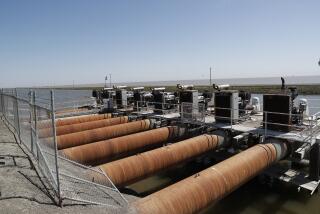Central California towns in trouble if Sierra snowpack melts too fast

The rain has mostly stopped after one of California’s wettest winters. (May 4, 2017) (Sign up for our free video newsletter here http://bit.ly/2n6VKPR)
- Share via
Reporting from Tranquillity, Calif. — The rain has largely stopped after one of the wettest winters in California.
But as spring temperatures begin to climb and snow in the Sierra Nevada melts, the threat of flooding has communities across the Central Valley on edge.
The storms that set a rainfall record in Northern California have left a vast layer of mountain snowpack, which now sits at almost 200% of average for the first week of May. In some areas, the snow is 80 feet deep, according to state and NASA reports.
Downstream, the rapid snowmelt is keeping public agencies juggling water levels across the state’s network of reservoirs. Water district managers conduct daily conference calls to coordinate how much water each expects to release into California’s labyrinth of rivers, creeks, bypasses and canals.
The coordination is crucial, as the reservoir releases affect water levels far downstream days later. Also, one reservoir’s release may meet with another, so managers must painstakingly chart how much water rivers and levees can support before overflowing.
The concerns are magnified in some areas by subsidence, a festering problem exacerbated by five years of drought in the Central Valley.
Though the land’s gradual sinking has been documented for decades in California, studies show that in Tranquillity and other Central Valley locations, the ground has begun to dip even faster in recent years. During the drought, mandates to protect fish and other wildlife in the Sacramento-San Joaquin Delta limited irrigation deliveries to farmers in places like Tranquillity, west of Fresno, and Corcoran to the south. Those farmers increasingly relied on groundwater pumping for their crops, which has caused the ground to sink by several feet in some areas.
This subsidence has lowered levee walls in some places and created dips in canal channels that can alter the flow of water.
“The levees, they’re just taking a beating,” said David Rizzardo, water supply forecasting chief for the state Department of Water Resources. “It’s like a boxing match, and the guy just doesn’t give up and he’s taking a left and a right to the face.”
A heat wave could cause chaos
In Mendota, where the Kings and San Joaquin rivers converge and flow north to the delta, subsidence has reduced the capacity of at least one adjacent flood-control channel, officials said.
The question remains how the system will hold up if a scorching heat wave or a warm rain rapidly melts the snow and the reservoirs aren’t ready for the surge.
“Just think of a bathtub fairly full, and now you have several bathtubs waiting to fill it and a very small drain on the other end,” Rizzardo said. “It’s like a maze that you haven’t figured out how you’re going to get out of yet.”
A warm spell this week prompted a new set of warnings for possible flooding. The biggest concerns were along portions of the Truckee and Merced rivers, where Yosemite National Park issued a warning to visitors that the picturesque Pohono Bridge could be flooded Thursday. Other rivers under watch include portions of the Sacramento and San Joaquin rivers.

Not very tranquil in Tranquillity
When the levee collapsed in 2006, Tranquillity farmers were desperate to stop the torrent of water that flooded their crops.
As Danny Wade tells it, irrigation officials couldn’t fill the breach fast enough, so one farmer decided to plug the hole with his sister’s Porsche.
“This was a nice-looking car that just needed some repairs to get it going again,” recalled Wade, the Tranquillity Irrigation District’s general manager. “His idea was: ‘We’re going to push the car off in that hole to slow the water down.’ He pushed it off there, and it ended up about 300 yards in the field. It looked like a boat going across the field. … Everyone still teases him to this day.”
Workers eventually repaired the levee with concrete, but several thousand acres of crops were destroyed.
Now, more than a decade later, this Central Valley community worries there may be a repeat of that 2006 disaster.
In the run-up to the flood, the aging, earthen levee system that protects towns and farms in the Sacramento and San Joaquin river basins was pounded by historic rains, weakened by saturation and compromised by burrowing wildlife — much as it was this winter.
Likewise, the Tranquillity levee failed in May 2006 when a weeklong heat wave melted the Sierra Nevada snowpack and sent runoff surging into the valley.
Squirrels and gophers are your worst enemy.
— Danny Wade, general manager, Tranquillity Irrigation District
In places like Tranquillity, a community of 1,000 residents and 10,000 acres of farmland, preparations for the snowmelt have been underway for months.
On a Thursday morning in April, Wade drove his heavy-duty pickup atop the levee that blew out in 2006 and sent water from the James Bypass canal onto fields of cotton and alfalfa seed reaching more than a mile east. He kept his eyes peeled for holes dug by animals.
“Squirrels and gophers are your worst enemy,” Wade said. “We were at a 95% chance or better of blowing out.”
The animals can create complex burrows, making the levees vulnerable to erosion when they come up against swift-moving water or heavy rain.
Two months ago, Tranquillity’s levee patrol found a north-south section that was compromised with seven gopher holes, Wade said.
So his district quickly purchased the 500-acre field next to the levee and excavated the land to reinforce the earthen mound.
“The option is: ‘Give up a few acres or all your onions are going to be underwater,’ ” Wade recalled telling the previous landowner. “It was an easy decision for him.”
For weeks, a private contractor and Wade’s eight-man crew spent every waking hour packing thick, dark soil onto the top and backside of the levee, with only four- or five-hour breaks for sleep.
‘You’re not stopping that flood’
No longer concerned about subsidence, Wade said the fate of Tranquillity now depends on whether the federally run Pine Flat Dam reservoir that feeds the town has enough space for all that snowmelt.
The reservoir can hold 1 million acre-feet of water and was about half-full on May 3. State estimates say there’s enough water in the snowpack in the mountains above — somewhere between 2.2 million and 2.5 million acre-feet of water — to fill the reservoir more than twice over.
“If we started getting a warm rain melting the snow too fast and they dump it … that’s the only way we would flood,” Wade said. “You could build these banks from here clear to Babel, and you’re not stopping that flood.”
If the levee in Tranquillity fails, water will have to be diverted to the south fork of the Kings River — and toward Corcoran and its state prison 60 miles south.
Subsidence has been a known issue there too, said Rizzardo, the state water-supply forecasting chief.
“It’s not like nobody wants to fix it; it’s just a hard fix,” he said. “It’s a lot of money and a lot of resources to do it.”
Preparing for a worst-case scenario
Dustin Fuller, manager of the Cross Creek Flood Control District, can attest to that.
“I can tell you farm ground will go under this year — I don’t know to what extent,” Fuller said. “My job is to look at the worst-case scenario, and the worst-case scenario is water encompasses this whole area.”
Though he’s taken state lawmakers on tours and explained what subsidence is and that new federal standards in the wake of Hurricane Katrina require wider levees, it hasn’t resulted in money for levee improvements here, he said.
According to federal standards, rural areas with sparse populations “might not be calculated to generate sufficient economic benefit to offset the costs of levee rehabilitation,” a state Legislative Analyst’s Office report in March stated. There is an estimated $2 billion worth of crops in Fresno, Tulare and San Joaquin counties, it said.
Fuller said if Corcoran flooded, it would cause $600 million in damage.

Taking matters into his own hands
Many of the state’s dams and weirs are at least 60 years old, and in the Central Valley, many were built more than a century ago, the report stated. It noted that flood-management responsibilities in California are spread among more than 1,300 local agencies managing an infrastructure of more than 20,000 miles of levees and channels and more than 1,500 dams and reservoirs.
In February, Fuller decided he no longer could wait for the politicians. He called a local contractor who has lived in the community for decades to supply the labor, hammered out a contract in a week with the Corcoran prison to excavate one of its wheat fields and launched a $14-million effort to raise 14 miles of levee wall by 4 feet.
Fuller said his agency will be able to pay off the contract by 2020. In the meantime, crews have piled on more than 700,000 cubic yards of dirt, enough to cover 120 football fields, on top of and alongside the area’s levees.
They are now 4 feet taller and 10 feet wider than they were before the drought, he said.
“We had to take the bull by the horns and get to work,” Fuller said. “I don’t have time to wait for the bureaucrats to square this mess out.”
For breaking California news, follow @JosephSerna on Twitter.
ALSO
California’s snowpack is nearly double its normal levels
Drought no more: Water flows back into the Silver Lake Reservoir complex
Researchers test a possible drought solution by flooding an almond farm
More to Read
Sign up for Essential California
The most important California stories and recommendations in your inbox every morning.
You may occasionally receive promotional content from the Los Angeles Times.











